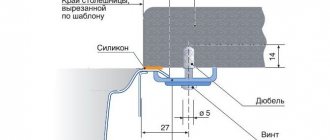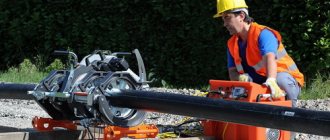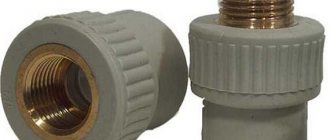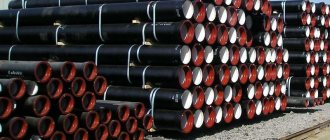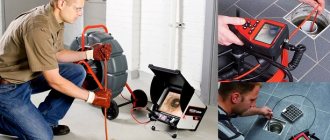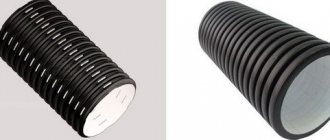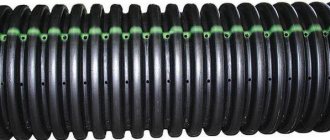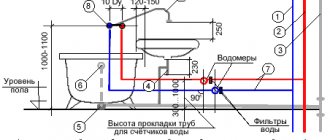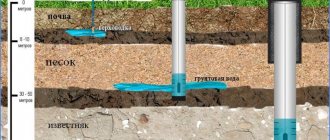Installation of HDPE pipes requires specialized equipment, certain knowledge and skills. High-quality installation of the pipeline eliminates the occurrence of leaks and guarantees trouble-free operation of the network and associated components.
In this article we will tell you how to install HDPE pipes for water supply. The information will be useful to production workers and novice craftsmen; it will help organize polyethylene water supply with low temporary losses.
Features of HDPE pipes
Water supply lines based on HDPE pipes have become widespread. They are in demand in agriculture and are used on private and commercial properties.
The high popularity of HDPE pipelines is due to the following factors.
- Chemical resistance. Systems based on HDPE work with drinking water, as well as low-aggressive media. They do not affect the composition of the transported product and do not create favorable conditions for the development of pathogenic microflora.
- Smooth inner surface. The HDPE pipeline does not contain grooves, bumps or other defects. This prevents the formation of deposits and allows you to maintain the permeability of the system for a long time.
- Resistance to corrosion. Rust does not appear on the surface of polyethylene pipelines. Maintaining the main line does not involve painting or removing corrosion.
- Low installation costs. Pipes based on HDPE are laid in the ground. When arranging the water supply system, concrete trays and other auxiliary components are not used.
- Dielectric properties. Polymer pipes do not conduct current and do not require additional insulation. They can be used as a cable route when connecting power equipment.
- Long service life. A polyethylene pipeline remains functional for 50 years. Compliance with operating rules increases the indicator to 60 and even 75 years.
- Light weight. The low weight of HDPE pipes allows you to save on delivery, loading, unloading and installation. The products slightly load the supporting elements when installed indoors.
- Excellent elasticity. Installation of HDPE pipes is simplified by their plasticity. The components bend without loss of strength and maneuverability. This minimizes the number of bends and adapters and allows the use of pipes in areas with increased vibration and seismic activity.
Significant elasticity guarantees resistance to water hammer and eliminates the risk of pipes bursting when water freezes in them.
The main disadvantage of the material is its vulnerability to high temperatures. When heated above 80 degrees, a decrease in the strength of products is observed.
There are two types of HDPE pipes on sale - intended for highways:
- working under pressure - gas and water supply networks;
- transporting the product by gravity - storm drains and sewerage systems.
Products differ in wall thickness and installation specifics.
HDPE grades
They produce 10 grades of suspension and 20 grades of gas-phase HDPE; according to GOST 16338-85, they are designated by digital symbols, the description of which is given in the specified document.
The designation of the PE brand according to GOST 16338-85 consists of a number of digital symbols and is deciphered by serial numbers as follows:
- — name of plastic, polyethylene;
- 1 – number, 2 – means that the polarization process was carried out at low pressure on the catalysts;
- 2, 3 — brand number;
- 4 - degree of homogenization, set to 0 if HDPE was subjected to cold mixing;
- 5 - numerical indicator of the density class:
6) - 0.931-0.939 g/cm
7) - 0.940-0.947 g/cm
 — 0.948-0.959 g/cm
— 0.948-0.959 g/cm
9) - 0.960-0.970 g/cm
- the numbers after the dash mean 10 times the average fluidity of the PE.
Based on the degree of crystallinity, polyethylene grades are distinguished: PE 32, PE 63, PE 80, PE 100. PE 100 has the best physical and chemical parameters, and, accordingly, PE 32 has the worst characteristics.
Nowadays, all factories have switched to producing HDPE pipes only from PE100 grade polyethylene, since this is the highest quality polyethylene, especially since many factories use imported raw materials in their production, and abroad have long switched to PE100 polyethylene.
Rice. 7 Technical characteristics of some brands of gas-phase PE according to GOST 16338-85
Connecting pipes using welding
Laying pipes by welding is based on the ability of heated polymers to mix with each other (diffusion). The procedure allows you to obtain one-piece units of increased strength. Such connections are in demand at industrial enterprises and critical economic facilities.
Installation of pipes using the diffusion method requires the presence of the following equipment:
- profile welding machine;
- centering clamps;
- trimmers.
The pipeline is laid in several stages:
- the pipes are cut perpendicular to the guide;
- rigidly fixed with clamps;
- the joining surfaces are cleaned with a trimmer;
- the cuts are heated with a welding machine to a given temperature;
- the ends of the pipes are connected with the required force;
- the joint is allowed to cool.
Upon completion of installation activities, the quality of the assembly is checked.
Features of making connections using the flange method
This method comes from joining metal water pipes. It is there that, using this method, all kinds of regulators, valves or latches, and other devices are mounted. In order to make a connection using this method, you will first need to weld special polyethylene bushings to the ends of the pipes. Then metal flanges are mounted on them.
When connecting polyethylene and metal pipes, loose steel flanges are used, the size of which corresponds to the size of the metal pipes.
Electrofusion welding
The welding procedure, which involves the use of special fittings and installations, places high demands on the preparation of the ends and simplifies work in hard-to-reach places.
To install pipelines using electric couplings, you will need to perform a number of operations:
- cut pipes taking into account the depth of the fittings;
- carry out mechanical and chemical treatment of cuts, removing irregularities and contamination;
- insert the prepared edges into the sleeve;
- connect the contact wires of the welding machine to special connectors on the fitting;
- activate the welding process.
The duration of the current supply is determined by the coupling parameters. The barcode on the product helps to set the indicator correctly.
Advantages and disadvantages
HDPE is low-density polyethylene, which is a polymer of ethylene. It is marked PE or PE and is white in color (thin designs are completely transparent). Sometimes HDPE products are painted black, blue, gray and other colors. A blue stripe on the pipe means that it can be used for water supply systems.
Most often, the installation of polyethylene pipes is carried out for the installation of cold water supply systems, sewage systems and a number of aggressive environments. The diameter of such products reaches 1600 mm. In addition, they are used for wiring the Internet, telephone communications, and power supply.
The main advantages of low-density polyethylene:
- long service life - some manufacturers provide a 50-year warranty on their products;
- affordable price;
- frost resistance - HDPE pipes can withstand multiple thawing/freezing cycles;
- inertness to chemicals - HDPE is highly resistant even to acids and alkalis;
- resistance to corrosion;
- environmental friendliness;
- safety for the human body;
- smooth internal surfaces prevent salts from settling on the walls;
- excellent ductility;
- high level of strength;
- small weight;
- easy maintenance;
- simple and quick installation.
Despite the wide list of advantages of polyethylene, it also has a number of disadvantages. The main ones:
- Low resistance to ultraviolet radiation. The material gradually deteriorates in the sun, so it cannot be laid outdoors without the use of special boxes and covers.
- Low heat resistance. HDPE products can only be used for transporting water with a temperature of no more than +60 degrees. To install heating systems, you need to use products made of cross-linked polyethylene.
- Unaesthetic. Some designs may not accommodate black or striped HDPE pipes.
- The operational characteristics of these structures do not allow their use in the industrial sector.
- Reinforced products have minimal flexibility.
Connection using fittings
A simple and affordable way to install pipes. When carrying out work, compression fittings with specified characteristics are used. Manufacturers offer a variety of mounting components. The wizard can assemble standard components, as well as implement non-standard solutions for connecting additional equipment.
The connection of pipes using fittings occurs as follows:
- cutting a pipe of a given size, cleaning its end;
- disassembling the fitting, removing the blue nut;
- putting the connector parts on the pipe, starting with the nut;
- pushing the end of the pipe into the center of the fitting;
- fixing the nut after contact between the pipe and the stop.
To secure the response element, the operation is repeated in the same sequence.
Upon completion of work, it is necessary to check the quality of connections. The presence of distortions, large gaps and other defects that contribute to depressurization of the circuit is unacceptable.
Types of detachable fittings for HDPE pipelines
A wide range of elements are used during installation operations:
- couplings connecting flat sections of the highway;
- bends creating corner connections;
- tees and crosses that form additional branches.
Manufacturers offer various adapters. Some allow you to connect plastic and metal components, others make it easier to work with polyethylene pipes of different diameters.
Usage
Processing methods
HDPE suspension polyethylene can be processed by all methods possible for PE materials, producing very high-quality products of various shapes, thicknesses and volumes:
- By the extrusion method, both to produce tubular material of various profiles and thicknesses, and by the flat-slot method,
- Casting molding objects (parts),
- Pressing flat products and large-area materials,
- Blowing out capacitive objects,
- Spray a thin layer onto existing surfaces.
Fasteners
The efficient operation of the pipeline is ensured by fastenings. They prevent displacement of the line, weakening of detachable units and deformation of loaded elements.
Fixing components during system installation occurs in two ways:
- formation of a fixed connection using special clamps;
- formation of a movable connection using hooks.
When laying a pipeline, it is necessary to fix each joint. The components holding the linear sections are placed in increments equal to ten times the pipe diameter. The use of clamps involves the installation of rubber gaskets that prevent mechanical damage to the line.
Results
If we try to summarize what has been said, we can say that polyethylene pipes will be an excellent option for a private water supply system designed for cold water. During installation, you need to carefully select the optimal connection methods. The choice will be based on many factors. This includes the expected maintenance during operation, the likelihood of alteration or repair of the system, and the conditions under which the pipeline is planned to operate. Despite the fact that the installation of HDPE pipes is quite simple, if you have doubts about your abilities, it is better to entrust all the work to professionals with specialized equipment.
Possible installation errors
Carrying out installation activities on water pipelines can be overshadowed by certain oversights:
- joining pipes with untreated ends;
- distortions of pipes within the coupling or weld;
- defects that reduce the tightness of the unit;
- use of substandard connecting elements;
- use of rigid fasteners without taking into account the linear expansion of materials;
- violation of welding regulations (excessive heating, non-compliance with temperature exposure periods).
Defective connections must be removed. Their place is taken by new sealed joints, made in accordance with the regulations.
On the recommendation of experts
Ivan Rodionovich Chernyshev, installation specialist: If HDPE pipes are welded, then you need to ensure that the following conditions are met. First, the weld should not be located below the outer surface of the pipes. Secondly, during welding, you need to ensure that the displacement of the joined sections does not exceed ten percent of the pipe wall thickness. Konstantin Kukushkin, foreman: The height of the weld bead can indicate that the welding was done efficiently. On a good seam, the bead should not be more than 2.5 millimeters in height - if the thickness of the pipe wall does not exceed 0.5 cm. For thicker pipes, this figure can be increased to 5 millimeters. In any case, the connection must provide the required degree of tightness - this is an indicator of the quality of the welding work performed.
Scope of use of HDPE pipes
Polymer pipelines are used when laying highways transporting the following media:
- drinking and technical liquids;
- gas fuel;
- wastewater;
- sewage;
- liquid technological products of low aggressiveness.
It will help to purchase pipes and components for connecting them. The company offers certified products of domestic and foreign production, rents out welding machines and other equipment.
To submit an application, contact the organization's managers. Specialists will talk about the parameters of cooperation and recommend solutions that meet your needs.
Main characteristics and types
HDPE pipes are often used to create water supply and sewer systems, for gas supply, and even for laying electrical cables.
Important: Such products can transport media with temperatures up to 40°C, if a pressure of up to 10 atm is created, and up to +65°C, if we are talking about non-pressure networks.
In order to choose polyethylene pipes for water supply and do it yourself correctly, you need to navigate the existing classifications of products. Thus, technical and food pipes are divided according to purpose, which can be used for sewerage and water supply, respectively, and according to the level of permissible pressure - pressure and non-pressure .
Pressure pipes are also classified according to the level of maximum pressure:
- lungs - up to 2.5 atm;
- medium-light - up to 4 atm;
- medium - 6 atm;
- heavy - 10 atm.
As for the dimensions, HDPE pipes are produced with a diameter of 16-1600 mm and a wall thickness of 2-72 mm. Geometric parameters should be selected based on the purpose of the pipe and its area of use. For the water supply of a private house, products of 20-30 mm will be sufficient, and for sewer networks - 90-160 mm.
Installation of HDPE pipes for water supply and other networks involves the creation of reliable butt joints that are stable even in areas with seismic activity.
Installation technologies
Do-it-yourself installation of HDPE pipes can be done in 2 ways:
Compression fittings for installation of HDPE pipes for water supply
- Creation of a detachable connection - socket using elastic seals or flange. Best suited for creating non-pressure networks. The type of joint is selected depending on the strength, complexity of the structure, and so on.
- Making a permanent joint using welding. This method is suitable for pipelines operating with media transported under high pressure. Welding requires specific equipment and couplings; it can be done end-to-end, in a socket or using an electrofusion method. Welded joints are strong, resistant to external influences and airtight.
Installation options
You can install a pipeline using HDPE pipes using one-piece or detachable technology. The choice of method depends on the required tightness and diameter of the pipe products. Welding is only applicable for pipes whose walls are at least 3 mm thick. This is a cheap and popular joining technique. Used for products with a diameter of 50 mm. Permanent type connections are used in places where it is necessary to ensure maximum tightness (gas pipelines, water supply, etc.) and on impressive diameters.
The soldering procedure is performed as follows:
- tubular products are cut and cleaned;
- after that they are placed in the coupling;
- the coupling is connected to the welding equipment and heated up, after which the outer part of the pipe and the inner surface of the coupling are soldered to each other.
When using fittings, you need to take into account that they come in several types. The most reliable of them:
- push fittings;
- press fittings;
- compression models.
Compression fitting elements consist of stops, seals, a threaded element and external crimp nuts.
Press fittings include a body, a press sleeve, a seal and a stop in the form of rings. When using this connecting part, a permanent connection is obtained with excellent tightness and high reliability. Most often, this technology is used for installing heated floors and gas pipelines.
